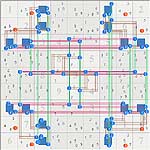ronk wrote:champagne wrote:Third group is a small list of other situations as example SK + BB . . .
dukdiamond1,coloin 3.2 SK *bb(2)r5c1289 r3c6 r7c4
I find the SK-loop and BB r46c5 r3c6 r7c4. What does r5c1289 have to do with it?
Good remark ronk. Let me try to answer with may-be to many details.
Preliminary statements :
1) Don't forget this is a kind of research.
2) For the time being, the solver scans all AC2 and all bi cells fo the form 123 123.
r5c1289 is (as r5c46) an AC2/AALS/AAHS and, as such, is scanned.
I think one reason why I included these patterns in the scan is that one fo the SLG constructions made by Allan for Golden Nugget had a similar definition.
3) The scan is done once. The idea is to focus on such patterns as a player could do,
4) When the SK loop is there, the scan is done after the SK loop has been cleaned. Forother puzzles, it is done the first time the solver reach the corresponding level of difficulty.
Back to our puzzle after SK loop was cleaned
- Code: Select all
1.......2.2.....6...34..5.....8.5.....8.3.9.....9.4.....5..34...7.....1.6.......7 dukdiamond1,coloin 3.2 SK *bb(2)r5c1289 r3c6 r7c4
1 45g89 46h79 |3e567 589 6789 |378 34j89 2
45G89 2 479 |13E57 589 1789 |1i378 6 34J89
7Â89 6H89 3 |4 12a67 12A67 |5 7ä89 1I89
-----------------------------------------------------------
23479b 13469B 1267 |8 1267 5 |1267 2347 1346
2457 1456 8 |12q67 3 1267Ã |9 2457 1456
2357 1356 1267 |9 1267 4 |1267 23578c 13568C
-----------------------------------------------------------
2p89 1k89 5 |1267d 1267D 3 |4 2r89 6n89
3l489 7 249 |256 4f589 2689 |236N8 1 35m89
6 3L489 1K249 |125 4F589 1289 |238 35M89 7
Just some statistic to start. after the SK loop was found, with a scan including all AC2's, the solver found many flying fishes.
Eliminating redundancy and inactive ones, I found (about)
40 using a start with digit 1
60 using a start with digit 6
30 using a start with othre digits.
It seems to me that this is a common situation after a SK loop clearing. It is much less in other cases.
Let's concentrate now on partial Exocets.
First group found by the solver uses theses flying fishes
- Code: Select all
7r5c18 => r1c3 r7c4 => r1c6 r7c4 => r1c7 r7c4 => r2c3 r7c4 => r2c6 r7c4
=> r2c7 r7c4 => r3c5 r7c4 => r3c6 r7c4 => r4c5 r7c4 => r6c5 r7c4
1r5c29 => r2c7 r7c4 => r3c6 r7c4 => r3c6 r9c3
6r5c29 => r1c3 r7c4 => r3c6 r7c4 => r3c6 r8c7
and the solver finds
AC2:r5c29 one match
1r5c29 6r5c29 => r3c6 r7c4
AC2:r5c1289 three match (among them 2 with double target)
6r5c29 7r5c18 => r1c3 r7c4 => r3c6 r7c4
1r5c29 6r5c29 => r3c6 r7c4 (the same as above)
1r5c29 7r5c18 => r2c7 r7c4 => r3c6 r7c4
Second group is yours
- Code: Select all
1r46c5 => r2c7 r7c4 => r3c6 r5c2 => r3c6 r7c4 => r3c6 r9c3 => r5c9 r7c4
6r46c5 => r1c3 r7c4 => r3c6 r5c9 => r3c6 r7c4 => r3c6 r8c7 => r5c2 r7c4
AC2:r46c5 one match
1r46c5 6r46c5 => r3c6 r7c4
AC2:r124689c5 one match (in fact it s the same)
1r46c5 6r46c5 => r3c6 r7c4
At the end, we have four "small" exocets (six if we split the "double matchs")
6r5c29 7r5c18 => r1c3 r7c4 => r3c6 r7c4
1r5c29 6r5c29 => r3c6 r7c4
1r5c29 7r5c18 => r2c7 r7c4 => r3c6 r7c4
1r46c5 6r46c5 => r3c6 r7c4
Only two of them are seen by the solver as being eliminated due to the double XWing pattern
6r5c29 7r5c18 => r1c3 r7c4
6r5c29 7r5c18 => r3c6 r7c4
Again, this is research. Does it bring enough simplification in the path after the SK loop has been found, this has to be analyzed. For the time being, I am focusng on a clean process of full Exocet pattern.
Sorry for such a long answer, I did not feel confortable with a shorter one
champagne



